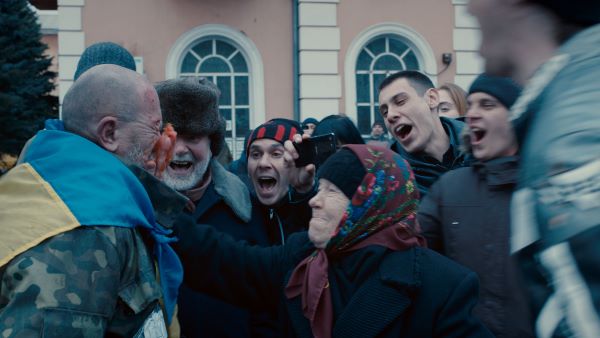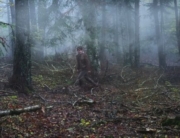Set in what the captions describe as the “occupied” section of Eastern Ukraine, director Sergei Loznitsa’s feature film opens with a trailer full of actors preparing for a scene. Accompanied by camera crews and what appear to be paramilitary forces, they’re led to the site of a bombing set off by the militia. Then the actors, who’ve been hired to portray eyewitnesses to the bombing, lament the current state of life in the region, aka the Donbass.
News of the bombing reverberates across all social tiers, helping to incite wrath against so-called “fascists.” But who are the fascists? Short answer: it’s complicated. Those who regularly check in on the ongoing conflict between Ukraine and Russia may recognize the Donbass as a current site of heavy fighting between the two countries. As of the film’s initial release in 2018 and into the present day, it’s a breakaway state, controlled by pro-Russia separatists (who are receiving aid from the Kremlin). Is knowledge of Eastern European geopolitics necessary to comprehend this movie, which doesn’t provide the viewer with any information through captions or other means? It’s definitely helpful, but even those who enter Donbass cold should be able to appreciate it as a deadpan depiction of a fallen society, in which the seismic effects of war for years have yielded lawlessness and chaos.
At first glance, its vignettes don’t appear to have a noticeable structure, other than the aforementioned acting troupe who reappear one last time. Protagonists are rarely in more than a single scene, which might make it seem as if the story line, if reshuffled, would play out exactly the same. But the way in which Loznitsa has organized the narrative is actually what makes it so effective—for example, the bombing is followed almost directly by a provincial government meeting. We would expect the incident to come up and possibly even be addressed, but instead a hooligan interrupts and brings the discussion to a halt.
The next sequence involves a flashily dressed, fast-talking huckster who dramatically pulls back the curtain on the theft of food and medicine at a hospital, only to be revealed as running his own grift. In one of the film’s rare instances of continuity, he drives to an army checkpoint, where it initially looks like he will be arrested, only the military is so decrepit that a simple identity check fails. Each of these scenes, which feature long takes that make them appear to be unfolding in real time, raises our expectations of the possibility of justice, yet that fails to occur. What develops instead is an increasing sense of how hopelessly dysfunctional things are.
Loznitsa smartly front loads the movie so that at first, the negative effects of this crumbling society are indirect. (The only clear exception is a bureaucrat who gets a bucket of feces dumped on his head, though his reaction is so calm that it’s played for laughs). However, that evolves quickly. The middle section is full of individuals who opt to abuse what power they have. In one of the most effective sequences, a nondescript businessman stops by a police precinct to pick up his car, which he had reported stolen. Although the policemen are civil, even cordial at first, things gradually descend into the stuff of nightmares as they demand he sign over his car, followed by all of the money he has. The businessman ends up locked in a room with countless other well-dressed men in similar straits, a surreal touch by which Loznitsa slightly blunts what we’ve just witnessed.
As evidenced from the beginning, media is a recurring theme throughout. There’s an instance in which a gang of young, mostly male hoodlums whip out their smartphones to film themselves beating a supposed “fascist.” As all of this footage conceivably gets broadcasted or posted online, Loznitsa questions the cumulative effect of this sort of constant bombardment: messages that incite violence, denigrate traditions, or present a very one-sided—that is, pro-Russian—view of events.
In his excellent 2021 documentary Babi Yar. Context, the director used archived footage to point out that a 1941 genocide of Ukraine’s Jews was not entirely under the orders of the Nazis; many Ukrainians took the initiative and began attacking their Jewish neighbors before the invaders arrived. Though fictional, Donbass could be a companion piece because of how it similarly depicts humanity behaving at its worst due to encroachments by a foreign power. However, as was the case with the genocide, in the end, it’s still Ukrainians inflicting the worst damage to themselves.

















Dear Mr Guie – i am very dismayed at your interpretation of some aspects of this film in which you claim – ‘as was the case with the genocide, in the end, it’s still Ukrainians inflicting the worst damage to themselves.’ and that Ukrainians stated attacking Jewish neighbours before the Nazis – i strongly suggest you read some upt ot date Historical accounts by Historians who have scoured soviet archives and checked out what you have ‘??? understood’ – lesia Zubjuk – father was in Soviet Army 39 – 42 [escaped / deserter] when Nazis caught up with 1st soviet army in Kharhiv – family assassinated by Soviets in 19 –
46 as punishment – the history is much much too complicated to make such generalised and simplistic observations
Hi Lesia. You seem to have attributed the ideas of Sergei Loznitsa, the director of Donbass, to me instead of realizing that I was actually commenting on them, but oh well. Thanks for reading!